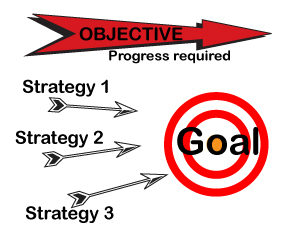
Asset Allocation strategy is a dynamic process. It plays a key role in determining the overall risk return of the portfolio. A model portfolio looks something like this:
Equity: 70% Debt: 10% Real Estate: 15% Gold: 5%

However there is no one ‘fit for all’ solution. A portfolio’s asset mix should reflect the long and short term financial goals at any time. Let us dwell upon a few strategies of establishing asset allocations and examine their basic management principles.
Strategic Asset Allocation:
This method is based on the over-all expected return of the portfolio. It adheres to a proportional mix of assets which together would give the expected return. If one aims at a return of 13% on his portfolio and if stocks historically have given an annual return of 15% and bonds 8%, then a mix of 60% in stocks and 40% in bonds would help him achieve his goal of 13% return. Since equity markets are volatile a portion of the investments are kept in bonds thus reducing the risk. This is the simplest and passive investment strategy of all. It is a buy-and-hold strategy, and a shift in values of assets causes a drift from the initially established expected return.
Constant Weighting Asset Allocation:
A constant-weighting approach to asset allocation addresses the problem of undue variations in the expected return. This approach needs continuous rebalancing the portfolio depending on the shift in values of the asset classes. If one asset has decreased in its value you will buy more of that asset, and if the value increases you sell a portion of it. This helps in rebalancing the portfolio and the expected returns are in tune with the financial goal. There is no hard-and-fast rule for timing portfolio rebalancing. A common rule of thumb is that whenever an asset class moves by more than 5% in value, we will rebalance the portfolio such that the original expected return is maintained.
Tactical Asset Allocation:
This is a moderately active strategy. While the asset allocation is strategized in tune with long term financial objectives, a portion of the assets is positioned in such a way as to benefit from any short term profit opportunity. Overall strategic asset mix is returned to, once the desired short term profits are achieved. This strategy demands a lot of discipline and one should be well versed with markets to recognize when short-term opportunities have run their course, and then rebalance the portfolio to its long-term asset position.
Dynamic Asset Allocation:
This is a very active asset allocation strategy. This is polar opposite of constant-weighting strategy. With this strategy one would sell assets that are declining and buy assets that are increasing in value. For example, if the stock market is showing weakness, you sell stocks in anticipation of further correction in the market; and if the market is bullish, you buy stocks expecting further gains in the market.
Insured Asset Allocation:
This strategy involves in establishing a base portfolio value, below which the value should not be allowed to drop. An active management strategy is exercised to increase the return on portfolio as much as possible provided the portfolio stays above the base value. If the portfolio should ever drop to the base level, you invest in risk-free assets so that the base value becomes fixed. This strategy may be suitable for risk-averse investors who desire a certain level of active management but understand the security of establishing a guaranteed floor below which the portfolio is not allowed to decline. Investors who wish to maintain a minimum standard of living post retirement can look at this strategy.
Conclusion:
Asset allocation strategy depends on the investor’s financial goals, earning capacity, age and risk tolerance profile. It can be an active process to varying degrees or strictly passive in nature. The above strategies are only general guidelines on how investors can use asset allocation as their core strategy in wealth creation or income generation.
